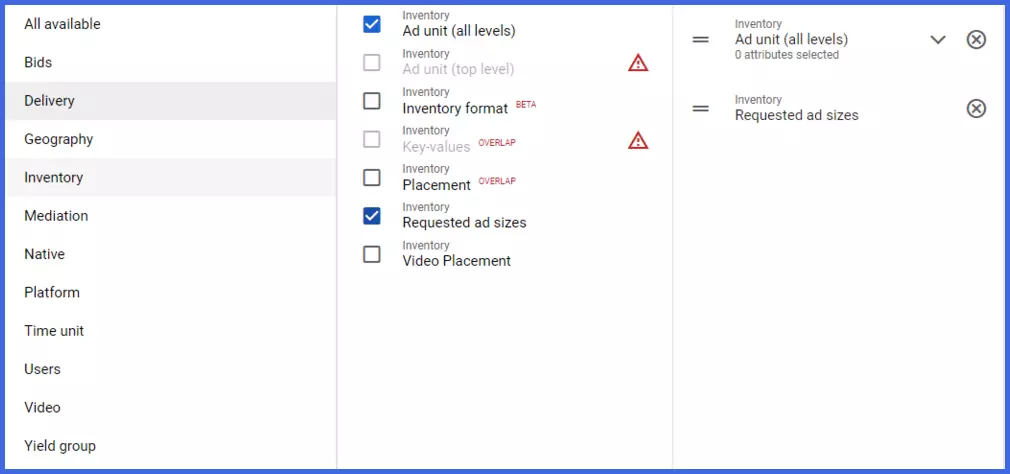Unfilled impressions in Google Ad Manager (DFP) is one of the most common issues faced by publishers. Regardless of size, traffic, and geo, publishers have to deal with unfilled impressions in Google Ad Manager. In fact, it’s unavoidable. However, there are certain practices to minimize unfilled impressions to 2% – 5%. And, that’s what we’re going to explore in this piece.
Table of Contents
What are unfilled impressions in Google Ad Manager?
Let’s start with the basics. What is an unfilled impression?
When a user loads a webpage, an ad request will be made to the server (In case of header bidding, it will be different – refer here). The server then calls the demand partners and expects their bids in return.
But, when the demand partners and ad networks predict that the impression is not right for any advertiser, they won’t send any bids. This, in turn, makes the ad server run a blank impression, and Google Ad Manager records the impression as an unfilled impression.
Why do you need to focus on unfilled impressions?
It is vital to track any unfilled impressions, as they represent the loss of revenue opportunities that can be revived through paid campaigns or direct deals. The reasons behind the unfilled impressions are numerous and unfortunately, some of the reasons are irresistible.
The best and easiest way to reduce revenue loss is to keep an eye on unfilled impressions so that we can continually amend and modify the settings to maximize the fill.
Even if you don’t have any third-party demands to fill the impressions, you could always traffic your own in-house ad (think webinars, conferences, etc). This, in turn, increases your conversions.
But, before getting into the ways to reduce unfilled impressions, we need to check the impact of unfilled impressions on your inventories.
Checking the unfilled impressions in Google Ad Manager
You can check the unfilled impressions data by logging on to your ad server (Google Ad Manager).
- Once you log in, click Reporting > Reports.
- Now, click New report. By default, the report type is ‘Historical’ which is fine to identify unfilled impressions. Give a name to the report.
- Select the date range (From-To).
- Go to Dimensions > Inventory. Include Ad unit (all levels) to view unfilled impressions for ad units of all levels or Requested ad sizes to view unfilled impressions by ad request size.

- Select ‘Unfilled Impressions‘ in the “Metrics” section.
- Run the report.
That’s it. With the help of the generated report, you would be able to make an educated guess on the location of tags serving the most unfilled impressions.
Tuning Tips:
Pulling report for Ad Units criteria:
– Select ad unit dimension and drill down in the order of rank.
– The ad units along with paired child unit companions will be displayed.
Pulling report for Ad request size criteria:
– Select ad request size dimension criteria (you can also select it in combination with ad unit or placement dimensions criteria).
– Unfilled impressions report for the request from tags gets fetched.
Another method to check unfilled impressions is by running a Google Ad Manager yield report.
– Select the yield report tab on the dashboard of your Google Ad Manager account section and click the reports tab.
– Under the report section, you can see the yield type and choose for unfilled impressions. This would help you to know which ad units get you the most unfilled impressions. Once you know, you can work on the ad units and reduce the unfilled impression.
What causes unfilled impressions?
Now that you have the data of the unfilled impressions, you are ready to optimize. Understanding the causes of unfilled impressions is as important as optimizing them. So, let’s take a look at the possible reasons.
- When there is a higher number of ad slots determined in the header of a GPT tag than the number of display calls, it leads to unfilled impressions.
- No Adsense or Network setup is in place for your ad inventory.
- Non-viewable inventories or ad units with depreciated viewability (lesser than 50%).
- Non-setup of House ads.
- Wrong setup of line items and orders.
- Unoptimized header bidding setup or no header bidding at all.
Minimizing Unfilled Impressions in Google Ad Manager (DFP)
1. Header Bidding* is the best way to avoid unfilled impressions as it brings more demand for your inventories. Besides, it increases the CPM of your impressions.
Header Bidding is a proven method to increase fill rates and increase CPMs. On the other hand, unoptimized implementation will result in a poor user experience. So, it is advisable to partner with the right header bidding provider.
2. For line items to serve efficiently, you should enable proper targeting criteria such as devices, connections, key values, geographic locations, etc.
3. Build inventory segments that have a higher chance of filling by third-party demand partners. Also, it is essential to partner with suitable third parties; not all bidder partners will be helping you with the fill rates.
4. As you have checked the unfilled impressions from reports in your account settings, you can adjust the frequency cap of line items (by testing at multiple frequency caps such as 5 impressions for a user in a day) accordingly to maximize the fill rate of third-party partners. By testing and adjusting the frequency cap, it is possible to settle on the higher fill rate.
5. Ensure value CPM for each line item. You might be having higher floor prices on certain ad units and demands wouldn’t be able to exceed the price all the time.
6. Substitute non-standard smaller ad units with the standard larger ad units.
7. Make sure your ad units are viewable. And, enable ad refresh only when ads are viewed by the users for a certain period. How can you do that? Check out AXT.
8. Experiment with the ad placements. Adding more ad units may decrease the fill rates and negatively impact the user experience.
What’s Next?
As we implied before, unfilled impressions will be there, always. Generally, 5 to 10 percent is considered as an acceptable rate. However, you can try to identify the ad units with higher unfilled rates and can close direct deals. Else, experiment with the strategies learned here and settle with the right one.
In case, you need any help with optimization, feel free to reach out to us.























